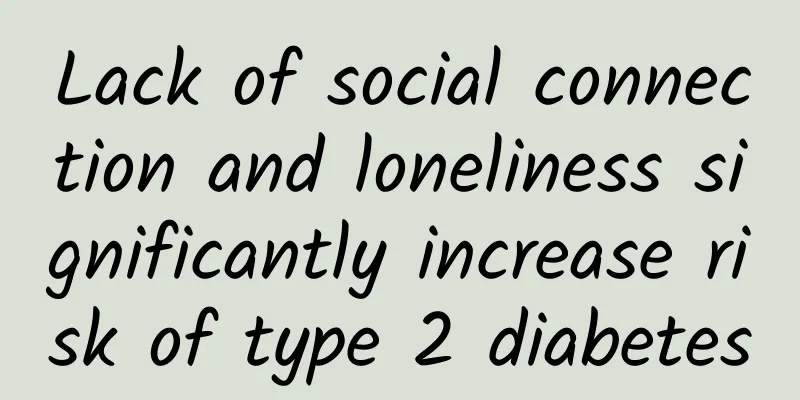Lack of social connection and loneliness significantly increase risk of type 2 diabetes

|
The global prevalence of diabetes has reached 10.5% and is still rising. Diabetes can lead to a variety of complications, high disability and mortality rates. Prediabetes refers to elevated blood sugar levels that have not yet reached the diagnostic criteria for diabetes. Every year, 5-10% of people with prediabetes eventually develop diabetes. Lifestyle management is an important measure for the primary prevention of type 2 diabetes, and psychosocial health is increasingly valued in the prevention of type 2 diabetes. The picture is from the Internet, the copyright belongs to the original author Humans are social animals. Studies have shown that social isolation (i.e., lack of social connections) and loneliness (i.e., loneliness caused by dissatisfaction with social connections) can have adverse effects on an individual's health, lifespan, and survival. On the one hand, social isolation and loneliness affect the body's biological functions such as the hypothalamic-pituitary-adrenal axis and sympathetic nervous system, and on the other hand, they lead to socioeconomic inequality, unhealthy lifestyles, and a higher risk of depression. These factors are all related to the risk of type 2 diabetes. So, **Do social isolation and loneliness increase the risk of type 2 diabetes? **Previous studies have not reached a consistent conclusion on this issue. It is worth noting that previous studies simply divided the study population into diabetic and non-diabetic populations, and did not focus on whether prediabetes status would affect the results. In addition, the question that previous studies did not answer is: Can the association between social isolation and loneliness and type 2 diabetes be entirely attributed to socioeconomic factors, lifestyle, and depression? To answer the above questions, researchers from the National Clinical Research Center for Kidney Diseases, Nanfang Hospital, Southern Medical University, recently published a research paper titled "Social isolation, loneliness, and the risk of incident type 2 diabetes mellitus by glycemic status" in the journal Diabetes & Metabolism . The results showed that after taking into account socioeconomic factors, lifestyle, and depressive status, social isolation and loneliness only increase the risk of incident type 2 diabetes in people with normal blood sugar levels (i.e., non-prediabetic people) ; in people with prediabetes, this association is mainly explained by socioeconomic factors, lifestyle, and depression. Professor Qin Xianhui from the Department of Nephrology, Nanfang Hospital, Southern Medical University is the corresponding author of the article, and graduate student Zhang Yanjun is the first author. The study included more than 350,000 participants with no history of diabetes who completed questionnaires about social isolation and loneliness. 14.5% of the population had prediabetes. Social isolation was defined using three questions about social contact, and individuals were considered to be experiencing social isolation if they met at least two of the following three criteria: (1) living alone ; (2) visiting friends or family less than once a month ; or (3) lacking social activities (e.g., going to the gym, participating in social group activities, adult education classes, etc.) at least once a week . Loneliness was defined using two questions and was determined if both of the following conditions were met: (1) often feeling lonely ; and (2) never or almost never confiding in close people . After about 12 years of follow-up, 13,213 participants developed type 2 diabetes. The results found that prediabetes status affects the association between social isolation and loneliness and diabetes. In people without prediabetes, social isolation and loneliness significantly increase the risk of type 2 diabetes, and this association cannot be fully explained by socioeconomic factors, lifestyle and depression. In people with prediabetes, after further considering socioeconomic factors, lifestyle and depression, the association between social isolation and loneliness and type 2 diabetes disappeared, suggesting that socioeconomic factors, lifestyle and depression played a major explanatory role. Among them, drinking, family income, sleep, loneliness and physical activity are the main explanatory factors for the association between social isolation and type 2 diabetes in people with prediabetes, mediating 12.6%-30.9% of the association; while body mass index and sleep are the main explanatory factors for the association between loneliness and type 2 diabetes in people with prediabetes, mediating about 17% of the association. These results suggest that even in people with normal blood sugar levels, we still need to pay attention to the harmful effects of social isolation and loneliness on the development of type 2 diabetes. In addition, in people at high risk of prediabetes, improving their socioeconomic status, healthy lifestyle, and mental health may help reduce the increased risk of type 2 diabetes caused by social isolation and loneliness. Say no to being alone and lonely, embrace health! Related Materials On November 15, 2023, the World Health Organization (WHO) announced that loneliness is a global public health issue and established a new Social Connection Commission (CSC) with the main purpose of promoting the recognition of "loneliness as a global public health priority" worldwide and providing resource support to form evidence-based solutions and then promote them globally. Therefore, it is necessary for us to pay attention to social isolation and loneliness groups and find solutions. References: Zhang Y, Liu M, Zhou C, Ye Z, Zhang Y, Yang S, He P, Gan X, Qin X. Social isolation, loneliness, and the risk of incident type 2 diabetes mellitus by glycemic status. Diabetes Metab. 2024 Mar;50(2):101517. Editor | Zhang Yanjun Huang Yu Audit | Qin Xianhui |
>>: There are benefits to cleaning your ears! But I don’t recommend you to…
Recommend
What to do if one side of the breastfeeding mother has milk but the other side does not?
The breastfeeding period is a very important peri...
How to regulate your body if you want a boy
Physical and mental health is the only wealth of ...
Toothache after exercise, go to the cardiology department! Please keep this "registration according to symptoms" guide
Do you go to the dentistry department for toothac...
Is it good to eat sugar apple on an empty stomach? How to ripen sugar apple
Sugar-apple is a common fruit in southern China. ...
What is the cause of acne at the vaginal opening?
Female friends must pay attention to relevant car...
Why does it hurt the first time?
Girls usually feel pain when they have sex for th...
Enterbrain: Japan's social game market size reached $1.45 billion in 2010
A recent report released by Tokyo magazine publis...
World Parkinson's Day | 5 Parkinson's Disease Myths, 1 of Them Is True →
Parkinson's disease is a neurodegenerative di...
Can aloe vera gel reduce stretch marks?
Can aloe vera gel get rid of stretch marks? In fa...
I heard that "period" can detoxify? Girls should know these questions about menstruation
Content from : Gu Zhuowei Shanghai Renji Hospital...
Apply erythromycin ointment to the episiotomy wound
Erythromycin is a macrolide antibiotic with an an...
We were chatting happily, why did we start arguing?
Produced by: Science Popularization China Produce...
Does cervical lesion require surgery?
The cervix is the name of the neck of the uteru...
How long does bleeding last after cervical conization?
Under normal circumstances, vaginal bleeding last...
Benefits of eating bird's nest in early pregnancy
Bird's nest is sweet and mild in nature, nour...




![[Guide to protecting your appearance] Revealing the secret of mandibular retraction, helping you easily deal with the problem of "small chin"!](/upload/images/67f0e7e17b1a8.webp)




